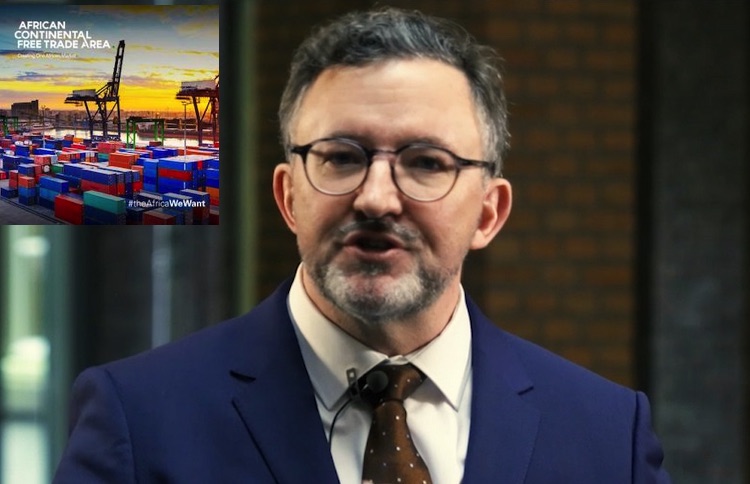By Busani Bafana
BULAWAYO, Zimbabwe (IDN) — The long-awaited African Continental Free Trade Area (AfCFTA)—set to be the world’s biggest free-trade zone by size—which entered into force on January 1, 2021, promises a new era for African trade.
An Africa-wide free-trade pact could bolster the region’s income by $450 billion and lift 30 million people out of extreme poverty by 2035, if accompanied by significant policy reforms and trade-facilitation measures, according to the World Bank. When fully operational, the Free Trade area will create a market of 1.2 billion and drive a combined GDP of $2.5 trillion. GERMAN | JAPANESE | SWAHILI
Dr Wim Naudé, Professor of Economics at the Department of Economics with the Cork University Business School in Ireland, explains: Trade is one of the great engines of economic growth and prosperity as it allows countries to specialize in the production and diversify in consumption.
Specialization in production allows for learning, innovation and higher productivity. Exchanging this for goods from elsewhere leads to higher consumption and welfare than what a country would be able to achieve in economic independence.
“The free trade area will strengthen all of these effects as there will be fewer barriers to access markets, larger markets, more choice for consumers, more competition to pressurize firms to be more productive,” Naudé tells IDN in an Email interview. Here important excerpts:
Question: Given the differences in economies across Africa, not to mention different trade policies, and in many cases barriers that exist in Africa, how do you see this free trade area harmonizing trade in Africa?
Wim Naudé: The free trade area will stimulate investment, innovation, and entrepreneurship. The AfCFTA is therefore good news and a historical opportunity for African countries. The fact that countries’ economies differ is no issue—in fact precisely because economies are different, trade is even more important to achieve gains in welfare.
Remember, most African countries are relatively small, and also, Africa has more landlocked countries than any continent on Earth—so removing trade barriers is even more important in Africa than for instance in large coastal countries.
Q: What opportunities does the African Continental Free Trade Area offer industrialization in Africa?
WN: Many African countries have since around 2000 been on a trajectory of industrial (manufacturing) growth, albeit from a small base. The trends are positive. In a IZA paper, I describe three varieties of African Industrialization taking place.
I expect that the AfCFTA will reinforce this: so it will allow (i) countries where advanced manufacturing (based e.g. on additive manufacturing, IoT, digitization) has taken place to scale this up (e.g. South Africa, Kenya, Nigeria) (ii) countries where basic labour-intensive manufacturing exist (e.g. furniture manufacturing) to be able to remain competitive for a longer time than without the AfCFTA (because of economies to scale) (e.g. Tanzania, Ethiopia) and (iii) countries where highly productive service-sectors, necessary for manufacturing, are becoming prominent—such as business services, logistics and transport (e.g. Mauritius, Botswana)—to be even more efficient in this and specialize more, as they can now provide these services across borders to manufacturers in other African countries much more easily.
Q: How can African countries achieve rapid economic growth through environmentally conscious industrialization and diversification while taking advantage of digitalization?
WN: The Paris Agreement of 2015 and subsequent COP (Conference of Parties) meetings have emphasized the need for rich countries to create an international funding mechanism to facilitate adaptation to and mitigation of climate change in developing countries.
Substantial funding is available for this. Africa, as a block, should intensify efforts to access and utilize this pot of funding to support investments in the industry. In terms of the TRIPS agreement (on Trade-Related Aspects of Intellectual Property Rights) as well, advanced economies committed themselves to the transfer of technology to developing countries. But this is not happening very fast or effectively—again, Africa as a block should demand adherence to this, for accelerated access to climate technologies.
Finally, one of the most important requirements for industrial development is access to cheap energy/electricity. We need to see the massive roll-out of electricity across the continent. For this, investment in nuclear energy plants will be needed across the continent to ensure reliable energy without increasing greenhouse gas emissions. Digital technologies are central to support all of these investments.
Q: How can Africa manage its debt and promote innovative finance for fiscal sustainability?
WN: In principle, African countries should borrow! The Continent should build up debt, and it can because it has a growing population (who will pay tax in future to serve debt), and investment opportunities that can offer high returns, given relative low stocks of capital. The only requirement is that borrowed money should be invested and spent wisely: spent on increasing production capacity. Then, countries fiscal position will be sustainable.
I am no great fan of so-called “innovative finance”—recall the global financial crisis with its destructive financial innovations such as CDOs (collateralized debt obligations)? Simple economic principles still offer the best advice—borrow, allocate these funds to productive activities (not to rent-seeking big businesses, or to bureaucrats in business and their families!) and sustain the debt through the increases in growth that these investments result in. [IDN-InDepthNews — 6 April 2021]
Photo: Dr Wim Naudé, Professor of Economics at the Department of Economics with the Cork University Business School in Ireland with the image of AfCFTA from the African Union website.




